
With its wet and windy weather, high aerobic output and general wear and tear, winter is hard on your waterproofs. So what makes the ideal shell for Scottish winter climbing and mountaineering?
We've reviewed ten of the best from leading manufacturers. The jackets on test here have been scored on a number of essential features: Weight; hem length; overall fit; helmet and harness compatibility; extra features; general robustness; and value for money.
Testing has taken place in a full range of UK hill conditions from warm and wet to snowy and windy; here's hoping for a white Christmas...
We've started off with a quick summary table, but for a full run-down of each jacket just scroll below.
Overall Summary
|
Model |
Price | Weight | Fabric | Rating | Summary |
|
Jottnar Hymir |
£230 |
350g (size L) |
Polartec Neoshell |
A true featherweight, this ultra-minimalist shell is also the most affordable in this review. It’s a specialised beast though. And watch that hem length. |
|
|
Rab Latok Alpine |
£260 |
512g
|
eVent 3-layer |
Simple and well cut, this strikes a fair balance between weight, features, price and durability. But the hood could be bigger. |
|
|
Marmot Spire |
£280 |
709g
|
Gore-Tex |
Tough and well built, but lacking the fine-tuned fit found on pricier shells, making it a better choice for hillwalkers than technical climbers. And boy it’s heavy. |
|
|
Sherpa Lakpa Rita |
£280 |
416g
|
eVent |
A good all-season all-rounder, this nice lightweight mountain shell comes at a reasonable price, but try the hem length before you buy. |
|
|
Berghaus Baffin Island |
£300 |
518g
|
Hydroshell Elite Pro and Hydroshell Air |
Long, roomy and well cut, this offers great weather protection without too much weight. A lot of shell for your money. |
|
|
Black Diamond Front Point Shell |
£350 |
555g
|
Gore-Tex Pro |
A tough, protective, good looking and highly featured shell, but the hood is too small and floppy and the pockets won’t suit everyone. |
|
|
Outdoor Research Maximus |
£370 |
599g
|
Gore-Tex Pro |
Excellent length and cut, a decent hood and general tough feel make this a great foul weather climbing shell. The side vents are of debatable merit though. And it’s heavy. |
|
|
Mountain Equipment Tupilak |
£380 |
554g |
Gore-Tex Pro | |
Reasonably heavy and by no means cheap, but this superbly designed shell has the optimum combination of features for Scottish winter. A worthy winner of best in test. |
|
Mammut Meron |
£400 |
539g
|
Gore-Tex Pro |
A well-built and durable winter shell, but at this price it is let down by niggles with hood and hem lift. |
|
|
Arc’teryx Alpha AR |
£450 |
414g
|
Gore-Tex Pro |
A superbly featured jacket for its minimal weight, with excellent tailoring and build quality. Floppy hood and sheer price are the downers. |
Jottnar Hymir £230
Weight: 350g (size L)
Fabric: Polartec NeoShell
Jottnar say: "a streamlined, focused, ultra-lightweight, technical hooded climbing smock, constructed from the world’s lightest grade of Polartec NeoShell. Building on the success of Jöttnar’s other NeoShell® products, Hymir was designed to be light and packable enough to be clipped to a harness, carried, or hauled without any undue physical penalty, whilst being robust enough to withstand rigorous use in serious conditions"
Fit
The only half-zip smock design on review, the Hymir has quite a roomy fit in the body to accommodate insulating layers, but in my size L sample it's not as long nor tapered in the body as the catalogue shots had led me to expect. Its spacious fit extends to the upper arms, while from the elbow downwards the sleeves taper steeply. The point is clearly to eliminate excess material at the cuff. If in theory this sounds a good idea, in practise those with thicker forearms might find it a little close when heavily dressed, although the fabric's stretch does go some way to compensating. It also takes quite some persuasion to coax the cuffs over a bulky glove. The hem has a resonable length at the rear, but for me it's disappointingly short in front, which means that under layers can poke out and get wet, and that the jacket has an unfortunate tendency to ride up out of a harness when you start waving your arms in the air.
Fabric
In the Hymir, Jottnar have used a lightweight 96g/m2 of Polartec NeoShell. It is soft and thin, with a slight stretch to aid freedom of movement. For its lightness it seems reasonably robust, but it clearly won't take as much abuse as heavier fabrics. If Polartec are to be believed NeoShell's breathability is up there with the best, and in use - even moving fast in summer - I've certainly had nothing to complain about here. In a more in-depth review of the Hymir (see here) UKC's Toby Archer noted that the soft material is less resistant to wind movement than a heavier, stiffer shell would be, and this is likely to have a bearing on how warm you'll feel in a winter storm. NeoShell is also more air permeable and therefore less windproof than some other fabrics. If you're steaming uphill then this doesn't matter - in fact it's a positive advantage - but what about long, cold winter belays? I've not yet had a chance to find out.
Hood
Though the hood is reasonably roomy, head movement is a little restricted with a high volume polystyrene climbing helmet (in our case a Petzl Meteor); we've found the fit a little better with a plastic shell-style helmet. However the height of a helmet beneath the hood can tend to pull the jacket's hem up at the waist, an effect most apparent when looking up. Tucked neatly but slightly inaccessibly inside the rim of the hood, the side adjustment toggles can be a fiddle, and they sometimes dig uncomfortably into the side of your face. The wired brim that helps the hood maintain its shape in the wind is a little more pliable and less sturdy than some, but not so you'd notice. The lower edge of the hood comes high enough to protect the chin, but not your mouth or cheeks. Overall the hood is not the Hymir's strongest point.
Features
There's little to say here, and I think that's to Jottnar's credit. The Hymir's feature set could hardly be simpler. You get a single chest pocket, large enough for a map or even - just - a pair of insulated gloves. There's a half-length "waterproof" zip (my inverted commas - none of them are), backed with a little fleecy bit at the chin. This is a lightweight zip more like those found on the pockets of the other jackets in the review, and as such I have to at least wonder about its potential longevity on a climbing shell. There are two elastic drawcords on the hood (one at the rim, the other around the back of the head) and a further cord at the waist. And that's it. Stripping out pockets, with their double layer of material, helps keep things light and airy, and the overall feel is functional and uncluttered. That's good, in a shell.
Summary
Minimalism and lightness make the Hymir a good choice for the specialised weight conscious niche. But because this shell offers a little less durability and weather protection than heavier competitors it's not the first jacket to pick for a long day of winter storms or a grovel up a granite chimney. If you don't need to be wearing it though, it's easily carried, and because of this I've taken the Hymir on many dry hillwalking and climbing days this summer and autumn. I'll be doing the same in settled winter weather too. Recommending this as a shell for days of better weather sounds almost a barbed compliment, but in fact it makes perfect sense. In winter I'm never without a shell, even for just in case, and in this role the lighter it is, the better. And if things did take a turn for the wilder then the Hymir is still up to the job. It's very reasonably priced too. Shame about the short hem length.
More info: www.jottnar.com
Rab Latok Alpine £260
Weight: 512g (size L)
Fabric: eVent 3-layer
Rab say: "The Latok Alpine Jacket is a true mountain waterproof, offering complete protection from the elements in a breathable and durable eVent® 3 layer fabric. Packed with technical features, the Latok Alpine Jacket is designed with a clean face fabric to help shed snow and rain, and includes innovative YKK® AquaGuard® Escape Artist™ pit zips for increased breathability when climbing or skinning uphill. Climbing specific features include a helmet compatible hood with wired peak, YKK® zips throughout and anti-snag Velcro adjustable cuffs. The Latok Alpine Jacket has been a staple in the Rab® waterproof range for many years now, and this current variation is the most advanced and technically featured yet, offering the ultimate protective package to climbers and mountaineers alike."
Fit
As you'd hope from a winter shell the Latok Alpine has enough room in the body to accommodate several layers. Hem length is fairly generous, particularly to the rear where I've got at least partial bum coverage. This length, and the cut generally, ensure there's minimal hem lifting when reaching overhead, so when climbing the jacket stays where it belongs under your harness waist belt. We are all built different, but on me at least the otherwise good freedom of movement is let down a little in the arms. While there's plenty of length here, and commendable amounts of room at the cuff for fitting over bulky gloves (easily cinched tight), I find the sleeves quite restrictive with a bent elbow.

Fabric
I know not everyone's a fan of eVent, but for me it feels comparable to other market leading fabrics - both breathable when you're working hard and solidly weatherproof. Considering its lightness the three-layer fabric used here seems pretty robust, and I've yet to make a mark on this test jacket after several days of scrambling and rock climbing. The jacket's smooth face is said to help shrug off rain, and the added advantage I think is that it's not prone to abrading on rocks. A slight stretch in the fabric goes some way to making up for the tighness in the sleeves.
Hood
Rab's hoods are generally a strong point, but though versions of the Latok Alpine jacket have been around for several years I'm not sure its hood has kept up with the trend towards higher volume climbing helmets. With a Petzl Meteor for instance, a popular polystyrene style helmet - albeit quite a big one - the fit is just slightly too close, and with the jacket zipped right up and toggles tightened head movement becomes a little restricted. Paired with a lower volume plastic shell style helmet however the hood fits very well and I've no complaints. There's decent fleece-lined lower face protection, and an effective wired brim that helps keep rain out of your eyes and isn't prone to flapping in the wind.
Features
The amount of storage on the Latok Alpine is sensible rather than excessive. Two large front pockets, positioned to avoid harness or rucksack straps, easily swallow a pair of ski gloves, with plenty of room still to spare for an OS map or whatnot. A single much smaller stretchy mesh-lined inner pocket is enough for a pair of liner gloves or a couple of cereal bars. The front zip is a reassuringly chunky YKK Vislon Aquaguard, and backed on both sides with an inner flap. These overlap to provide a very effective barrier to any water that does make it past the zip. Zip pulls in day-glo plastic are a nice touch. Now for the pit zips: It's only when you come to use them that you notice something unusual. Instead of being centred on your arm pit, as most such vents seem to be, they run from under the arms right down to the wrist. As a result if you're really steaming up you can remove your arms from the jacket entirely - I guess that's the 'escape artist' bit in Rab's product description. I've not yet felt the need, but it's nice to know I could.
Summary
I've had an older version of this jacket for the last eight years or so, and it's seen a lot of use from Scottish winter climbing and year-round hillwalking to exotic 5000m peaks. I have always liked its simple functionality, and its reasonable balance between lightness and durability. It packs down bearably small, it keeps the weather off, and its cut is generally well suited to climbing. If you can get on with the closer fit of the hood and arms this is a solid mountain all-rounder at a very fair price.
For more info see rab.equipment/uk
Marmot Spire £280
Weight: 709g (size L)
Fabric: 3-layer Gore-Tex, 4.9 oz/yard
Marmot say: "We didn’t skimp on anything when designing our most affordable offering in a three-layer GORE-TEX® Performance Shell. With exclusive features like the laminated wire rim of our Gale Force hood with ERG adjustment system, Angel Wing movement and laser-drilled pocket backing for enhanced breathability, the Spire jacket is the perfect go-to shell for intense outings."
Fit
The body of the Spire is on the roomy side, good for cold-weather layering. In terms of this review it's about medium length, so while the hem does come below the waist an extra inch here would make quite a difference to the protection offered in bad weather, particularly when you're not wearing overtrousers. The fit of the sleeves is rather tighter than the body, and I find it slightly restrictive at the elbow with a fully bent arm. Cuffs can be fitted over thick insulated gloves, but it can take a little persuasion, and a smidge more space here would be appreciated. It is fair to say the tailoring is not the best in this review, with the result that the jacket's hem lifts significantly when arms are raised in the air, to the extent that it tends to ride up out of a harness - a bigger deal for climbers than hillwalkers.
Fabric
As one of the more budget-conscious offerings, the Spire is the only shell in this review to use standard Gore-Tex rather than the higher performing and thus more expensive Gore-Tex Pro. While the waterproof-ness of the two fabrics is broadly similar the breathability of the standard version is somewhat less. It is hard to get hold of definitive figures comparing the two, but in use I've found I can only really feel a difference when working very hard in warmer, wetter conditions. Though it does not boast Pro's level of long-term durability the 3-layer Gore-Tex used here is a sensible choice for durability, paired here with a fairly heavyweight face fabric to make a good robust mountain jacket that's fully up to the hard wear of winter walking and climbing. A degree of stiffness in the fabric helps it resist excessive flapping in the wind, so it can feel warmer than a lighter weight shell - a good thing in a winter jacket. However there's no stretch, and perhaps you wouldn't expect it at this price. But more noticeable is the weight: at over 700g the Spire is by a big margin the heaviest shell on test here.
Hood
With enough volume for a Petzl Meteor (other helmets are available) the Spire's feels like a proper winter climbing hood. Movement is pretty good overall, except for the slightly limited chin room when looking upwards with the jacket zip fully fastened. Volume adjusters are the standard toggles on elastic, one at the rear and one on each side, and while they give a good fit both helmeted and helmet-free, they are quite a fiddle to operate wearing gloves. At least the elastic tails are tucked well out of the way where they can't whip you in the face. The hood offers really decent lower face coverage for foul weather protection, with a nice soft brushed inner. However it is let down by the brim. The laminated peak is fine, but although Marmot specifically mention the wire rim this flaccid offering is disappointing in windy winter weather, and while the hood holds its shape over a helmet, it flaps and catches the wind as soon as this is removed.
Features
The main zip, a chunky YKK thing, may not be ostensibly waterproof, but this is compensated by a hefty double storm flap, with a big old fashioned (not in a bad way) external velcro-secured flap in addition to the internal zip-backing strip that comes as standard in modern shells. I suspect the external flap might start to show its limitations in a wind-driven deluge - the velcro tabs are quite widely spaced - but if this did happen, there's still the inside gutter, which seems pretty effective. Two large external pockets are sensibly placed to avoid rucksack straps and harness, and have plenty of volume for big thick gloves, OS maps and the like. Thanks to their construction most of the front of the body is covered by two layers of Gore-Tex, but to compensate for the reduced breathability here the backing layer is a seive of laser-cut holes. Pocket zips are lightweight but 'wateproof' (to the extent that any zip really is). Inside there's a single mesh-backed pocket of useful size. Pit zips are fairly small on the Spire, which means a little less through-draught than in some other shells on review. There's a single zipper rather than the more usual two. More concerning is the lack of a waterproof zip here, and while it's tucked away inside layers of storm flap I can't help pondering if this could prove a weak point in prolonged very wet windy conditions. Uniquely in this review, the Spire has a removable internal snow skirt, something that will appeal to skiers.
Summary
A protective and well-built shell that's fully up to the rigours of winter climbing, what the Marmot Spire lacks in finesse it makes up for with brute toughness. The hood is good for climbers - it could be excellent with the addition of a stiffer brim - but the general cut of the jacket rather lets it down out on the crag, and we feel it'd be better used primarily for winter hillwalking and general mountaineering than more technical routes. If you've less than £300 to spend and want a shell to last, this is the one. The downside? Its sheer weight.
For info see marmot.com
Sherpa Lakpa Rita £280
Weight: 416g (size L)
Fabric: eVent® waterproof/air permeable laminate made of 40D x 40D with a 70D ripstop
Sherpa say: "Lakpa Rita was the first Sherpa to climb the highest peaks on all seven continents. He also happens to be our toughest critic and gear tester. This jacket is named in honor of him, and it’s our best waterproof/breathable hard shell – period. Made of the finest materials available, it features design and construction details specific to serious alpine pursuits. Two eVent® waterproof fabrics – strategically placed nylon ripstop and nylon taffeta – feature Direct Venting™ technology: water stays out while perspiration vapor escapes through microscopic nano-vents."
Fit
The Lakpa Rita is not quite as long in the body as some of the other shells on test here, offering marginally less protection down below as a result. Though the hem does sit below the waist I find there's something about the cut of the jacket that gives it a tendency to ride up when my arms are raised - enough lift to slip out from under a harness. Perhaps it's ill-matched to my body length, but marginally more hem length and more room under the arms might have avoided this. In Large size it's a little closer fitting than some equivalent shells, though still roomy enough for cold weather layering. There's plenty of length in the sleeves, and the cuffs are broad enough to slip over a pair of bulky ski gloves - with persuasion.
Fabric
Two different eVent fabrics are used strategically, with most being a more durable ripstop. Both have a slight stretch to aid freedom of movement. It's 40D throughout, which may prove less durable than thicker fabrics (only time will tell), but certainly helps keep the weight down. A disadvantage of using thinnner, more supple fabric is that it is less resistant to moving in the wind, potentially making insulation less effective thanks to air movement inside the jacket. But again, on the credit side there's that low weight. Sherpa are one of only two manufacturers in this review to submit an eVent shell, and the figures for its performance on paper (hydrostatic head 20,000mm - breathability 20,000g/m2/24hrs) are identical, for example, to the alternative fabric used by Berghaus. Though we haven't tested them all for waterproofness and breathability in controlled conditions, in use it feels like it performs on a par with other fabrics. Being light and breathable, the Lakpa Rita is a good choice for a year-round shell too, not just for winter.
Hood
There are one or two things to criticise here but it's mostly very good. First the good: The Lakpa Rita's hood is big enough to accommodate even a polystyrene helmet, and you can move your head entirely unrestricted. The brim is stiffened with a good length of wire, making an effective but reasonably unobtrusive weather-shedding peak. Another plus point is the simplicity of the adjustment, a single length of elastic that runs around the back of the head and down around the lower face. It works - perfectly effectively - via just one toggle at the back, leaving you free of the side toggles and tails of elastic flapping in the wind that you sometimes find in other hoods. Unfortunately the toggle itself is pretty hard to operate in thick gloves. More critically, the hood is cut a little too low at the front, offering limited protection for the chin, mouth and cheeks from spindrift or biting wind.
Features
Want plenty of pockets? You got 'em. Two larger, lower pockets - placed out of the way of a harness of rucksack hip belt - are big enough for thick gloves and OS maps, while two much smaller upper pockets are only good for things like cereal bars or a compass. Given their limited usefulness Sherpa might arguably have done without the upper pair and instead made the lower pockets larger and positioned slightly higher. As it stands, the extra layer of material backing all of these pockets covers most of the front of the jacket. Though it could I suppose be argued that a double layer in front helps make the shell a little warmer, for venting purposes a large-woven mesh might have been preferable. It's not something I'd lose sleep over, but it might be worth mentioning the venting question in light particularly of the Lakpa Rita's lack of pit zips. Pocket zips are of the skinny 'waterproof' variety, while the main zip is a robust YKK Vislon Aquaguard. A colourful woven zip pull adds a litte Nepali prayer flag-esque detail. Finally the hem adjusters, toggles neatly inset into the hem, are operable wearing gloves.
Summary
A competent mountain shell at a reasonable price, the Lakpa Rita does however have a few flaws - notably its short hem length, its tendency to ride up when climbing, and the hood's lack of lower face protection. This latter is particularly unfortunate given that the hood is otherwise excellent. Though the pocket arrangement strikes me as fiddly, others might find it suits them fine. Its chief selling point? You get a lot of jacket for not much weight, making this a good year-round all-rounder.
For more info see www.sherpaadventuregear.co.uk
Berghaus Baffin Island £300
Weight: 518g (size L)
Fabric: Hydroshell Elite Pro and Hydroshell Air
Berghaus say: "an Innovative Alpine Jacket With Leading levels of breathability and protection. Designed by our MtnHaus® team and engineered with our innovative body-mapped zoning, the Baffin Island Jacket combines a hybrid of waterproof technologies to provide the ultimate mix of protection and breathability for alpine use. Berghaus’ own waterproof technology, Hydroshell Elite Pro, is utilised in the main body areas, offering the highest levels of durable waterproof protection within our Hydroshell range, whilst key reinforced areas greatly increase strength and abrasion resistance in the zones which need it most. Our new Hydroshell air technology offers leading levels of breathability and is carefully positioned in key heat zones for enhanced comfort. This unique combination of technologies offers the ultimate mix of performance rather than the usual compromise of protection vs breathability."
Fit
I seem to bang on about hem length whenever I write up a jacket. But really there's nothing to be gained by styling a shell fashionably short when an extra few centimentes can make a big difference to weather protection, and help keep a jacket under the harness where you want it. Berghaus clearly agree, and the Baffin Island is one of the longest-cut shells in this review. At the rear the hem comes low enough to completely cover my bum - when wouldn't you want this? - and the front sits only marginally higher. Only the rear of the hem has elastic adjustment, while a clever little stretchy cut-out keeps the front of the jacket snug without being restrictive. This makes for a nice uncluttered front hem that fits nearly beneath a harness. Overall, room for insulating layers is sufficient without making things baggy, while the underarm cut lets you lift your arms freely without also lifting the hem. There's tons of room in the sleeves, in case you ever need to fit a duvet inside, but the velcro cuff can also give a good close fit around the wrist.
Fabric
In the Baffin Island Berghaus have combined two of their own proprietary fabrics, using body mapping (the current buzz word) to put each where it works best to optimise the balance of waterproofing and breathability. On most of the trunk and arms the more waterproof Hydroshell Elite Pro (hydrostatic head 20,000mm - breathability 20,000g/m2/24hrs) gives high levels of weather protection and durability. Meanwhile where the body generates most heat, under the arms and down the back, it's the less protective but lighter and more breathable Hydroshell Air (hydrostatic head 8000mm - breathability 40,000g/m2/24hrs). In use this combination works very well, making for a weather-proof and fairly durable jacket that still feels light and highly breathable. I've not tested it in a lab, but out sweating in the rain I've no complaints.
Hood
This generously proportioned hood swallows a modern high-volume climbing helmet with ease, with a cut that gives little restriction to full head movement. There's a high collar too for maximum lower face protection. Its larger-than-average peak helps keep raindrops out of your eyes, and though it can catch the wind a little its stiffened brim holds a shape well. Without a helmet or at least a hat underneath to raise it, the peak does rather make you feel like you're peering out from a deep cave. Comprising a single piece of elastic that runs around the back of the head and across the top of the forehead, tensioning is quite a nifty arrangement and one that gives a good fine-tuned fit. But even once you've found them the toggles - two hidden in the seams and a big one at the back - they are a fiddle with thick gloves on. The Baffin Island's hood feels like a real refuge from foul weather; bring on the belays in spindrift rivers.
Features
Backed with a stretchy mesh inside that helps with venting, the two hugely generous Napoleon pockets hold a map and a bulky pair of insulated gloves with ease, and there's a smaller third external pocket too. All have "waterproof" zips. That would do me for storage, but not content with three, Berghaus have also added two inside mesh pockets and a sixth slightly curious bit of tiny pocket detailing on one sleeve. Perhaps this is for your ski pass, and though I never have one of those it is just about big enough to hold my Oyster Card. The jacket's main zip is reassuringly chunky, and boasts a huge glove-friendly plastic zip pull and a soft brushed chin guard. There are no pit zips on the Baffin Island, but between the venting pockets and the extra breathable underarm panels I can't say I've missed them.
Summary
It's function over fashion here - you won't be winning any points for style. But with its spacious hood and generous length the Baffin Island has a nice protective feel in foul weather. This is a well-cut jacket too, offering good freedom of movement when climbing. Berhaus' own Hydroshell fabrics may be less well known than leading competitors, but on the hill its performance seems indistinguishable. Some shells are lighter and some easier on the budget, but the Baffin island offers a good all-round compromise of weight, features and price. Nice one Berghaus.
For more info see www.berghaus.com
Black Diamond Front Point Shell £350
Weight: 555g (size L)
Fabric: GORE-Tex Pro
Black Diamond say: "The Front Point Shell is our most durable, protective three-layer hardshell. Featuring GORE-TEX Pro fabric for uncompromising waterproof and breathable protection, the Front Point uses integrated Cohaesive™ technology in the hood and hem, an embedded cord-lock for fast, one-handed adjustments. An assortment of highly functional pockets handle all the essentials needed for technical alpine outings, and two-way zippered armpit vents allow for quick heat dumps."
Fit
With its spacious cut, there's room inside the Front Point for several layers. The hem comes nice and low for weather protection below the waist, and it does not tend to want to pull up out of a harness when you're climbing. Sleeves are long, with an excellent wide cuff for easy fitting over bulky gloves. However, on me there's a little tightness to the sleeve when the elbows are fully bent, and a restrictive feel across the tops and backs of the shoulders when the arms are raised, which slightly compromises full freedom of movement. I think I have a fairly standard frame, neither body builder-thick nor stick insect-skinny. None of us are exactly the same shape, so it might just be unlucky that the Front Point doesn't really fit me.
Fabric
In common with the other higher-budget shells in this review Black Diamond have gone for Gore-Tex Pro here, a top choice for climbing and mountaineering shells thanks to its high levels of breathability and durability. The current Gore-Tex Pro came out for the winter 2013/14 season. It's made for the rigours of winter climbing, and as a result Gore say it's their toughest fabric to date. But it is also highly breathable - as much as 28% more so than the previous generation of the fabric. That's according to their lab tests; all I can say anecdotally is that in the real world I've found it performs brilliantly across a full range of seasonal conditions. The Front Point pairs this membrane with a smooth-feeling and beefy 80D face fabric. It certainly feels up to the rough and tumble of winter climbing, and also doesn't flap in the wind too much, helping to keep you warmer inside.
Hood
As a climbing gear company I expected a lot of a Black Diamond shell. But I'm a little disappointed in the Front Point's hood. I don't have a Black Diamond helmet to test it with, so settled for the Petzl Meteor, an obvious choice of head gear and the one we've used with all the shells in this test. With the zip down below your chin all is well, but when it's done up all the way there just isn't sufficient space, so head movement is pretty severely restricted. Results are more favourable with a lower-volume shell-style helmet. The hood comes high to protect the lower face, and has a nice brushed backing strip. The brim rather lets things down though, a soft structureless laminated affair that catches any wind going, meaning that in stormy weather the hood only really holds its shape when stretched over a helmet. I'll end with a positive, and although it's a small thing it is really quite noticeable when you're out in the weather: the elastic volume adjustment toggles. One to the rear and one on each side, these big wide discs are sewn firmly into the seams, making them easily located and operated with gloves on, one-handed. Assuming they never need replaced (how would you?) they are the best adjustment thingies in this review.
Features
There's a lot going on here. First to hit you is the pockets. The two main chest pockets are offset, one significantly bigger than the other - presumably a style thing since I can't think of a practical reason for it. When stuffed full these stand out, bellows-fashion, from the front of the jacket. I wondered at first if this design might be prone to snagging, but in use they seem fine. They can obscure the view of your waist a bit though. The smaller of the two bellows pockets has a little internal pouch for an MP3 player or some such. Only the larger of the two main pockets is big enough for an OS map, and even this only just. You want reliable zips on a winter shell, and for these two pockets and the main zip Black Diamond have used YKK Vislon Aquaguard, backed in the case of the main zip with an internal storm flap. Zip pulls are brushed metal, very swish looking but perhaps an odd choice for cold and wet conditions. In addition to the main pockets there are hand-warmer pockets too, though they can only be accessed when you are not wearing a harness or rucksack hip belt (when's that, exactly?). For ventilation there are lighter weight waterproof pit zips, nothing remarkable but perfectly useful. Down at the hem you've got two more of those sewn-in adjusters. Did we say how much we like them?
Summary
This is a good looking jacket, and there are things to like about it. But other features need more thought, from the slightly-too-small and floppy hood to the fussy and vaguely impractical pockets. If you want a tough, protective shell for hillwalking and mountaineering that you can also wear unselfconsciously around town then the Front Point is worth a look; but for more serious winter or alpine climbing it wouldn't be our first choice.
For more info visit eu.blackdiamondequipment.com
Outdoor Research Maximus £370
Weight: 599g (size L)
Fabric: Gore-Tex Pro and Pro Stretch, both 3-layer and 70D
Outdoor Research Say: "an alpine workhorse built with waterproof, breathable GORE-TEX® Pro 70D fabric and GORE-TEX® Pro Stretch panels in keys areas—such as under the arms, and on the elbows and hood—to enable even greater freedom of movement. Replete with features to batten down the hatches when a wicked winter storm blows through, the rugged Maximus ensures you'll be protected regardless of conditions or terrain."
Fit
For its stated size this is probably the roomiest shell of the lot, with loads of space for layering underneath. Though it feels quite voluminous when you're lightly dressed, this large fit would make it a good choice in colder conditions. There's also plenty of length in the body, with a hem that comes low - particularly at the back where it basically covers your bum to offer maximum weather protection. Thanks to the length, volume and thoughtful tailoring there is no problem with the hem lifting with your arms raised, and when climbing the Maximus stays snugly under a harness. Sleeves are long, and nicely curved, but the cuffs could do with being ever so slightly wider to make them easier to slip over a pair of ski gloves.
Fabric
This is another of the shells to use Gore-Tex Pro, a solid choice in top-of-the-range jackets thanks to its high performance, weatherproofness and durability. As well as the lab-tested properties of the fabric, a shell's breathability in use is affected by its design. In this respect more layers of material and a profusion of taped seams could be considered a bad thing, and initially I wondered if the many pockets on the Maximus could be a case in point. A lot of the layering is mesh however, and out on the hill I can't say I've noticed any undue steaminess. Though most of the jacket is Gore-Tex Pro paired with a heavy-wearing 70D face fabric, Outdoor Research have also added small, strategic panels of Pro Stretch at the elbows, armpits, back of the neck and (for some reason) the inner wrist. The combination offers both freedom of movement and durability.
Hood
The spacious hood accommodates a high volume polystyrene helmet (Petzl Meteor), with only very minimal restriction to head movement when the zip is fully fastened. Without a helmet it tightens very effectively, with one elastic cord running right around the head at hat brim height - a really good system - and more elastic around the sides of the face. Unfortunately the rear toggle is a faff to operate with thick gloves on. A big laminated and wired brim helps keep rain and spindrift out of your eyes, and resists flapping in the wind. In my experience it's unusual for a North American-designed jacket to have a wired hood, a feature that really comes into its own in a Scottish winter hoolie (don't they have wind?). The hood also comes high enough to protect your chin. Overall, excellent.
Features
Four external pockets give you tons of storage. Others might disagree, but for me there are two too many and the Maximus would be better with just two slightly larger main pockets. But even as they are, these are still easily roomy enough for ski gloves and OS maps. You can just about cram one insulated glove into each of the smaller upper pockets too. One (not both) of these small pockets can also be accessed through an inside zip. I've found no use for this. The Maximus has venting zips, but of an unconventional bent. Instead of being located under the arms these run from somewhere near the armpit, down each side of the body to the hem. You can air yourself through an opening at about ribcage height, or, should you so wish (I haven't yet), each side of the jacket can be unzipped from the bottom to about halfway up. There must be some logic to this arrangement, but in practise I've only found it inferior to a conventional pit zip, since the size of the opening is quite limited when you're wearing either a harness or a rucksack hipbelt (between them, that's 100% of the time). You could vent instead through the pockets, but then they'd be vents, not pockets. All external zips are robust YKK Vislon Aquaguard, but while the main front zip is backed by an internal gutter flap, the side vents have no storm flap at all. Even these market leading, nominally water resistant zips have their limits in wind-driven rain, and while I've had no cause for complaint so far I don't think it's unfair to at least ponder the ability of the side vents to keep out every drop in a real all-day British soak-fest. Of course if you're only going out in sub-zero conditions that's no issue. The hem drawcords only reach around the rear half of the jacket, leaving the front nicely uncluttered. However the toggles need two hands to operate, and they're too small for gloved hands.
Summary
Maximus? It's well named. Big, beefy, and offering maximum foul weather coverage, this feature-packed shell is a solid choice for the toughest of sub-zero conditions. Pushing it on the heavy side but reassuringly durable as a result, it feels like the sort of kit a Mountain Rescue Team would issue. When it's packed - not altogether compactly - in your sack you might think it's overkill, but if the weather goes pear shaped you'll quickly change your mind. It's winter only though - I wouldn't be routinely carting this around in June. The only thing we really don't like is the quirky side vets.
For more info: www.outdoorresearch.com
Mountain Equipment Tupilak £380
Weight: 554g (size L)
Fabric: 3-layer GORE-TEX® Pro 80D fabric throughout
Mountain Equipment Say: "A technical shell jacket ideally suited to alpine and expedition climbing on the steepest lines and biggest faces. A serious, stripped back shell that shines on the most difficult modern lines. The combination of GORE-TEX® Pro 80D fabric, Alpine fit and our proven Super Alpine Hood make this one of the finest and most robust climbing jackets available."
Fit
I tested a previous version of the Tupilak last year (see full review here), and since there have been no changes to the design (just the fabric - see below) I'm in danger of repeating myself. Luckily it was all good last time. Being cut sensibly long in the body, the Tupilak offers plenty of weather protection below the waist - particularly to the rear, where it pretty much covers your bum. The cut of the sleeves allows unrestricted mobility, and there's absolutely negligible hem lift when your arms are raised. As a result the shell stays reliably under your harness when climbing. There's plenty of room in the body and sleeves for cold weather layering, but not so much that it's baggy. And the cuffs are broad enough to pull easily over a pair of thick gloves. Of all the jackets on test this one fits me best: everyone's different, of course.
Fabric
ME's choice of Gore-Tex Pro is hard to argue with. Where the previous version of the Tupilak paired Gore-Tex Pro with a mix of 40D and 80D face fabric, the latest generation is 80D throughout. This thicker face fabric offers increased wear resistance, and while that's not an issue I'd noticed formerly it does add to the bombproof feel of this rugged shell. In addition it doesn't billow in the wind as much as a lighter fabric would, which arguably aids the performance of insulating layers beneath. Since the change has added less than 20g to the jacket's weight (on my kitchen scales) it can only be a good thing.
Hood
The Tupilak's hood has remained unchanged from the previous model, and rightly so. It's the best in this review. Here's what I wrote last time: Cut generously to accommodate modern high-volume helmets, this 'Super Alpine' hood is Mountain Equipment's largest. Retreat, tortoise-like, into the cavernous sanctuary of the hood and you feel well covered from the worst of the elements. Though very spacious at full extension it can also be pulled tight with draw cords concealed in the hem and at the rear to give a very effective wind-proof close fit around a helmet-less head - a rather better seal than on some hoods I've tried. The stiff wired-and-laminated brim resists deforming and flapping in the wind, and directs raindrops away from your face. With a snug high collar there's plenty of protection for the lower face too, just what you need when the spindrift starts stinging. When pulled snug the hood moves well with your head, letting you just get on and climb without feeling impaired.
Features
Again, I can't do better than paraphrase last year's review: Up out of harness range are two large chest pockets, spacious enough for gloves, hat and map. Inside you get a single smaller mesh-backed pocket, good for loose items you might want to hand. That's plenty of pockets, in our opinion. The main zip and pocket zips are YKK Vislon Aquaguard, chunky and confidence-inspiring, backed with a drainage flap. For ventilation you get pit zips, a lighter weight YKK WR zip, laminated and bonded rather than sewn-in, to reduce seams. Down at the hem is the usual elasticated draw cord, with sewn-in adjusters that sit neatly beneath a harness and are easily used with gloves. The cord is 'dual tether' rather than a closed loop, so it won't accidentally snag on any protrusions or get clipped into a karabiner by mistake. It's a sensible range of features with nothing extraneous or gimmicky.
Summary
It's not the lightest, and it's certainly not a budget option, but for our money the Tupilak has the optimum combination of features for the rigours of Scottish winter climbing, hillwalking and mountaineering: Long in the body; very well tailored; sensible choice of extras; top-of-the-range breathable membrane paired with a tough face fabric; and a brilliant hood. On a foul weather forecast this is the shell we'd be most likely to reach for. A worthy winner of the best in test.
For more info visit www.mountain-equipment.co.uk
Mammut Meron £400
Weight: 539g (size L)
Fabric: Gore-Tex Pro
Mammut say: "a robust and durable 3-layer GORE-TEX® Pro jacket. The waterproof and vapor-permeable materials make it particularly suitable for tours subject to extreme weather influences"
Fit
By the standards of this review the Meron is a mid-length jacket, offering reasonable weather coverage below the waist. However the articulation of the sleeves is not as effective as some, and as a result you do get a degree of hem lift when raising your arms overhead. On me at least it has a tendency to bunch up from under the harness. Room in the body is sufficient for layering, but not so much that it feels baggy when you're more lightly dressed. Arm length is good, and there's room in the sleeves for bulky layers, while the cuff is wide enough to sit easily over ski gloves.
Fabric
Developed to meet the demands of mountaineers, the latest generation of Gore-Tex Pro is, they say, the toughest and most breathable yet. It's a pretty standard choice for modern top-end mountain shells, including several in this review, and having used jackets made from it for everything from hillwalking on warm wet summer days to foul weather winter climbing and high altitude snow plodding, I'm impressed by its performance. Here Mammut have paired it with two different face fabrics, smoother and lighter weight on the trunk, hood and underarms; more hardwearing on high wear areas down the outer arm, across the shoulders and at the hem. The overall feel is robust and fairly stiff, which is good for wind resistance.
Hood
The hood is spacious enough for a typical polystyrene helmet, in this case a Petzl Meteor - but only just, since the brim rides pretty high on the helmet, offering little protection from above (spindrift rivers, anyone?). In terms of head movement all is well and good when the jacket is zipped below your chin, but zip it right up to your nose and things do get just a little restrictive. I've tried this instead with a lower-volume shell style helmet and the fit and movement are much better. The Meron's floppy unwired hood brim really needs a helmet under it to hold its shape in a wind. Elsewhere however the hood scores much better marks, coming right up to nose level to give the face some really snug weather protection. Adjustment is made with the customary three toggles, one at the rear (very hard to operate wearing gloves) and one to each side (glove-friendly). If it's not stretched over a helmet, a fully cinched-in hood results in long tails of elastic hanging free. These have hard plastic ends which could quite conceivably whip you in the eye in a high wind
Features
Sitting well clear of harness or rucksack straps, the Meron's two external chest pockets are easily big enough for gloves and map, with room to spare, and secure with a very durable YKK Vislon Aquaguard zip - in contrast to the lighter but possibly less bombproof zips used on many other shells' pockets. Inside are two much smaller mesh-only pockets, which shouldn't hinder breathability. If things do start getting steamy, however, pit zips offer plenty of venting. The jacket's main zip is also a YKK Vislon Aquaguard, backed with a pretty robust internal storm flap. Hem drawcord toggles sit neatly out of the way to the sides, and can be used reasonably easily with gloves on.
Summary
The Meron is a well-made, functional mountain shell with a very durable feel. Its top-of-the-range Gore-Tex Pro membrane and fairly stiff face fabric offer plenty of foul weather protection, yet it comes in a reasonably lightweight package. The hood is good, but not top in the class thanks to a couple of niggles. While the hem length and general cut did not ideally suit me, they might be fine on someone with a different build: Try before you buy, especially at this price.
For more info see www.mammut.ch
Arc'Teryx Alpha AR £450t
Weight: 414g (size L)
Fabric: N80p-X GORE-TEX® Pro 3L and N40p-X GORE-TEX® Pro 3L
Arc'teryx say: "A finely tuned balance of light weight, extended durability, ergonomic performance and superior weather protection, this is a solid choice for climbers and alpinists looking for an all-round hardshell to perform across the spectrum of alpine conditions. The Alpha AR has a streamlined athletic fit and ergonomic e3D patterning that deliver maximum freedom on rock and ice."
Fit
Cut fairly long in the body, the Alpha AR offers a good level of protection below the waist, particularly at the rear where most of the bum is covered. Sizing in the body is generous to accommodate several insulating layers with ease, while the tailoring of the sleeves and around the shoulders permits a full range of movement. When your arms are raised there's negligible hem lift, and the jacket stays reliably below a harness. Nifty little foam inserts inside the hem are designed to keep the jacket in place, but given the overall length and the great sleeve articulation this addition is hardly needed. Sleeves are long and roomy, with cavernous cuffs that easily swallow a bulky ski glove.
Fabric
As with the other high-end jackets in this review Arc'teryx have gone for Gore-Tex Pro, the most durable and best-performing fabric in the Gore range for serious mountain use. Here's it's partnered with two different weights of face fabric, tougher stuff across the shoulders, over the top of the hood and from the elbow down the forearm to the wrist; and lighter weight material everywhere else. It feels fairly robust overall, and though it might not prove quite as hardwearing long term as some of the heavier shells the flipside of this is the Alpha AR's low weight: 414g (size L) is impressively light for a fully featured mountain shell. The lighter weight fabric does crinkle like a crisp packet when you move, and it flaps in the wind more than a stiffer material would too, which does have a minor bearing on the effectiveness of your insulation.
Hood
The Alpha AR's helmet-friendly hood has loads of volume, easily accommodating a polystyrene helmet without restricting head movement. Peripheral vision is excellent, though the brim does slightly obscure the view when looking up. With helmet removed the hood cinches down neatly, but the adjustment toggles - two at the sides and one on the rear - are unfortunately a bit small and fiddly to use wearing thick gloves. A more serious niggle is the brim. The hood's laminated peak has only the bare minimum of structure, and since it lacks any stiffening wire to help hold its shape it does tend to catch the wind and flap around. Our unscientific view is that the Alpha AR's hood resists the wind marginally better than the other non-wired brims on review, but it's still not ideal in a highland hoolie. When your hood is stretched over a helmet this is much less of an issue of course. The hood's high collar gives good protection to the chin, but less for mouth and cheeks.
Features
Extras on the Alpha AR are sensibly restrained. Outside, two chest pockets, sat up high away from harness and rucksack straps, offer enough room for a pair of bulky gloves and - just - an OS-sized map. Inside there's a single less roomy stretchy pocket that'll hold a couple of cereal bars or a smaller phone. Underarm zips give a nice wide opening for ventilation. All external zips are 'waterproof' - a robust YKK Vislon Aquaguard for the main zip and lighter weight zips elsewhere. The storm flap backing the main zip is the narrowest of all the jackets on review, so if any wind-blown rain did manage to penetrate this far it's conceivable that it might also find its way past the flap. Seems a shame to have skimped here by 1cm.
Summary
The Alpha AR is an excellent shell for the weight conscious climber, but without an major compromises in terms of functionality and weather protection. Plus points include the superb tailoring, simple features, top notch Gore-Tex Pro, helmet-friendly hood and a composite construction that balances toughness and lightness. Downers - and we can only think of two - are the lack of wired hood brim and the frankly eye watering price tag.
For more info go to www.arcteryx.com












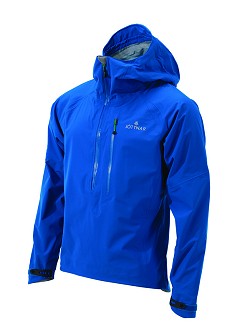


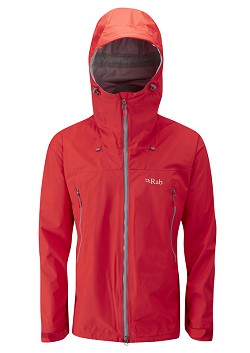
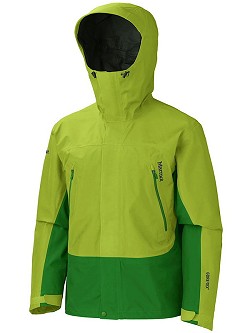

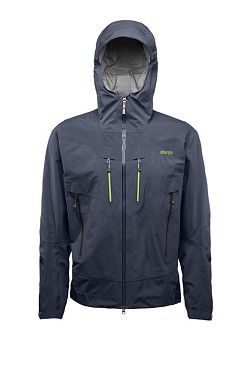
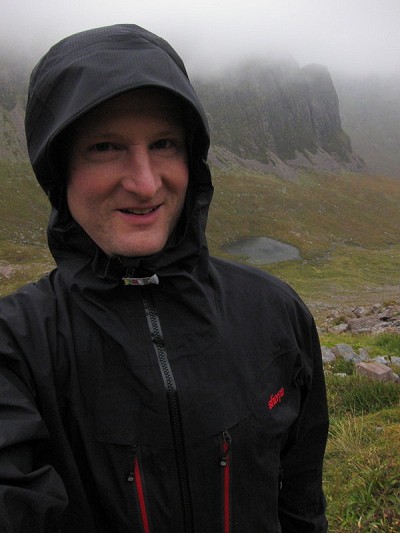

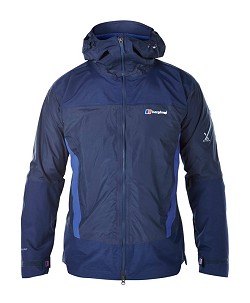
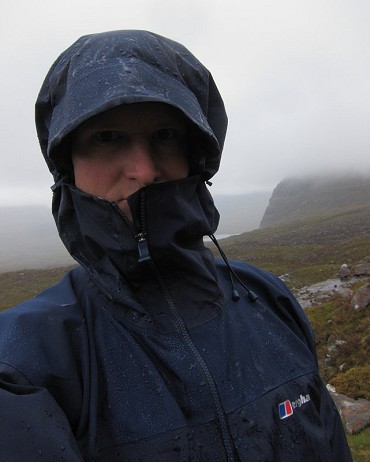
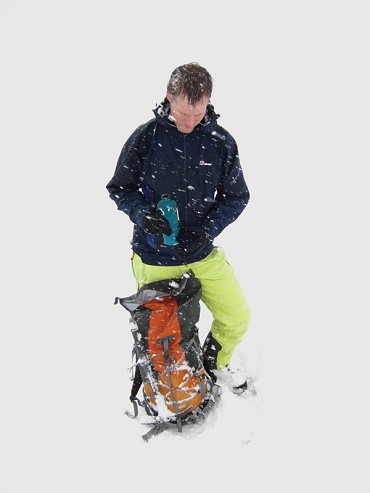
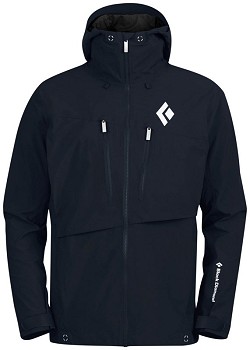

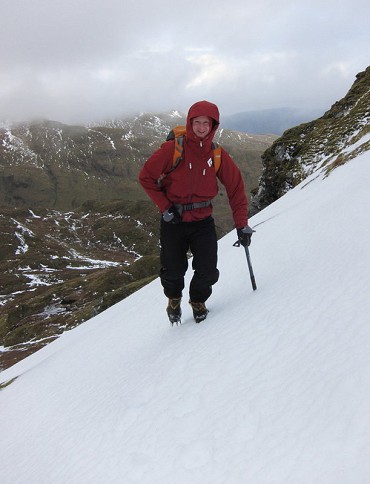
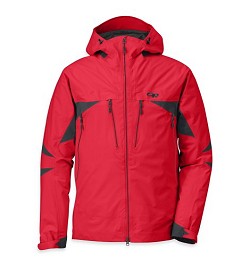
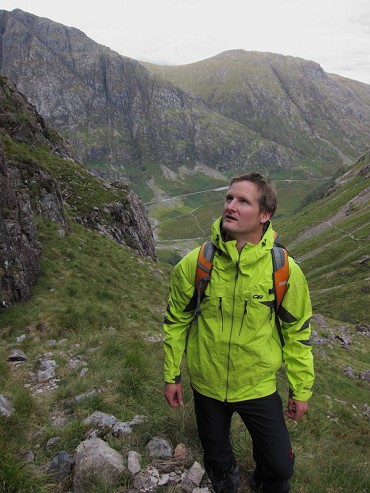
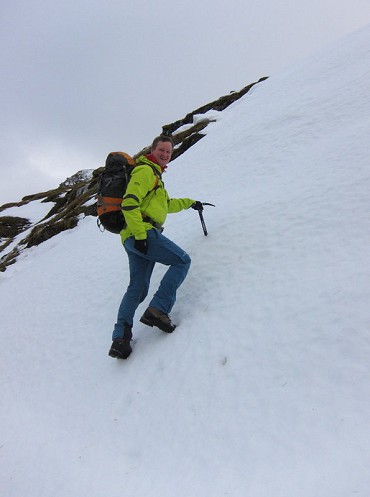

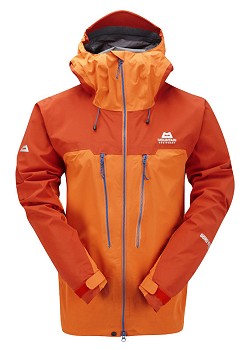

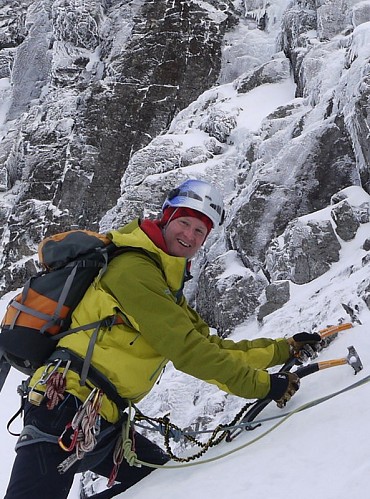
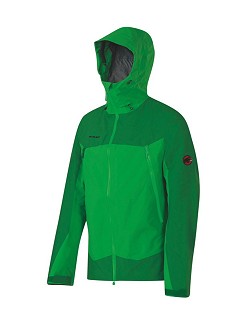

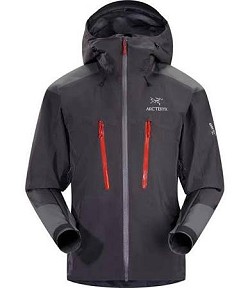

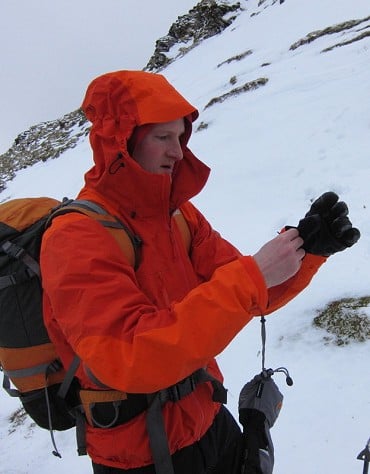
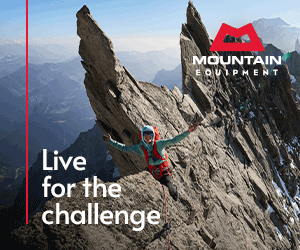







Comments